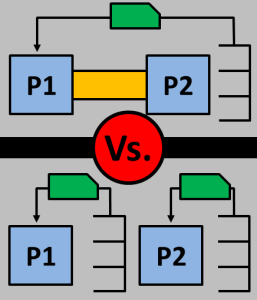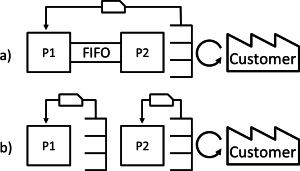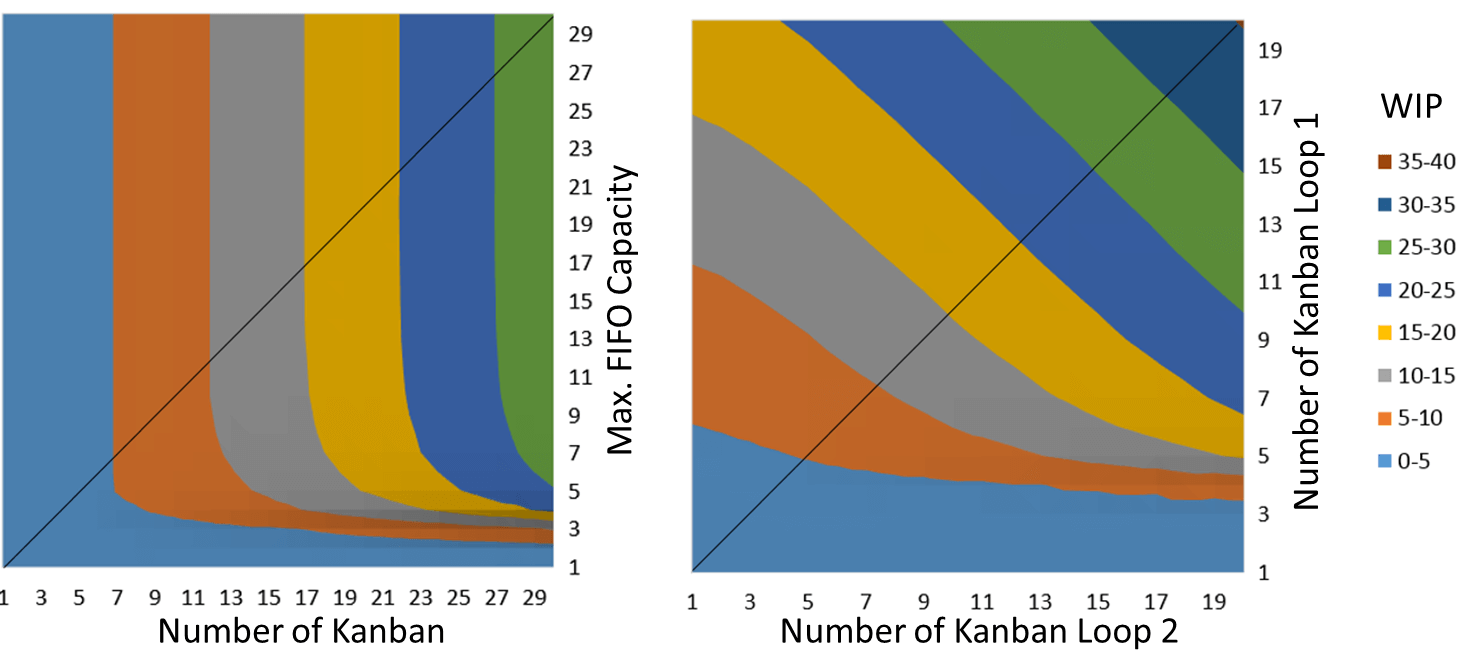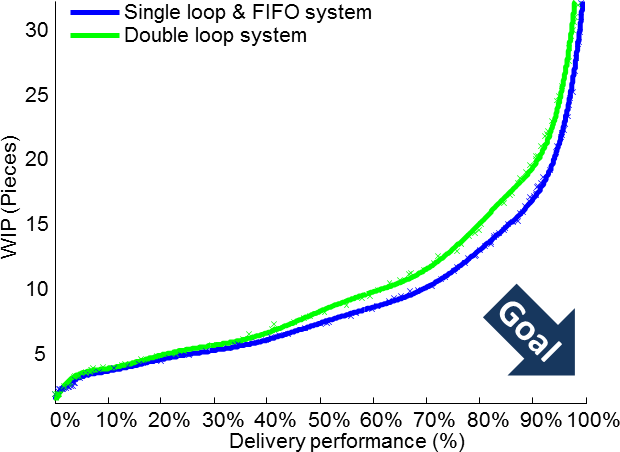 To create pull production between two processes, you can add either a FiFo lane or a supermarket. In one case you will have the FiFo as part of a bigger kanban or CONWIP loop, and in the other case you split the value stream into two different kanban or CONWIP loops.
To create pull production between two processes, you can add either a FiFo lane or a supermarket. In one case you will have the FiFo as part of a bigger kanban or CONWIP loop, and in the other case you split the value stream into two different kanban or CONWIP loops.
Some questions that I have been pondering are: Which one has less inventory for the same delivery performance? Is it better to use a big loop or two smaller loops for the WIP and delivery performance trade off?
Introduction

In almost all cases, pull systems are superior to push systems (read, for example, my posts on The (True) Difference Between Push and Pull and Why Pull Is So Great!). Good flow shop pull systems are implemented using either kanban or CONWIP loops. And here you have multiple options. You can make one big loop with FiFo lanes between the processes, or you can split it into multiple smaller loops by adding supermarkets between selected processes. I have already looked at the question on when to use supermarkets and FiFo based on ease of use. More details are available in my posts Ten Rules When to Use a FiFo, When a Supermarket – Introduction and The Rules, as well as Top Five Cases When NOT to Use a FiFo.
However, so far I have not yet looked into the aspects of inventory or work in progress (WIP) and the influence on the delivery performance. As you surely know, reducing inventory is a constant drive in industry in order to reduce the associated costs. Similarly, delivery performance is also high on the agenda of most managers. Unfortunately, they are usually somewhat inverse related. More inventory often gives you a better delivery performance, and vice versa. Hence, I gave a master’s student the task to look into it, and this student did an excellent job of looking into these details (source below).
Analysis

To keep things simple, we analyzed a small system having only two processes and only one part type. We always compared the performance of a single loop with the performance of a double loop.
We did vary the cycle times quite a bit for both processes as well as the customer. Naturally, the customer always had to be a bit slower than the processes, or otherwise the delivery performance would go toward zero. We varied this speed difference between the customer and the processes. We also varied the speed difference between the processes. We experimented with different types of random distributions and different standard deviations for the processes and the customer. In short, we tried to replicate as many different situations as possible that can be expected in industry.

For each system, there were two variables we could play with. For the first system we could set the number of kanban cards and the maximum capacity of the FiFo lane. For the second system we could set the number of kanban cards for either loop.
With these variables we did an exhaustive search. We analyzed pretty much any combination of number of kanban and FiFo size for the first system as well as any combination of number of kanban for the second system. In short, we pretty much tested every combination, also repeating it multiple times for accuracy. The image below shows, for example, the WIP surface plots for all combinations of kanban and FiFo size for the first system as well as any combination of number of kanban for the second system.

Similar surface plots were also done for the delivery performance. All of them were also done for many different set-ups with respect to cycle time and customer demand.
Results
The question we wanted to answer was: Where do you need less WIP – one loop with FiFo or two loops? Out of the mass of data, we always looked for the best combination of inventory and delivery performance. In other words, if I set up my system perfectly (more on that later), what is the lowest WIP I can get away with for a certain delivery performance, or, similarly, what is the best delivery performance I can get for a given WIP?
The graph below shows you the best trade off between WIP and delivery performance you can get for both a single loop and FIFO system and a double loop system where the two processes had equal cycle time and the customer was 10% slower. However, no matter which system we simulated, the results were all very similar. In all cases the single-loop system was better than the double-loop system.
These two lines are close together. We also went through the difficult math using confidence intervals and statistical hypothesis testing to verify that this difference is not just a random fluke. The difference is statistically significant for delivery performances above 50% – which is where most factories are. More similar results can be found in the sources given below.
Interpretation

Thinking about it, these results make sense. In cases of low demand, inventory will pile up at the end of the loop. For a single-loop system, you will get a big pile at the end, whereas for the double-loop system, you will get two smaller piles as shown in the picture.
If this period of low demand is followed by a period of high demand, the single-loop system can deliver all parts immediately if necessary. The two-loop system, however, can deliver only the second pile, whereas the first pile still has to go through the second process. Hence, it is more likely that the two-loop system may miss a delivery.
Relevance
 Hence, using a single larger loop requires statistically significant less inventory for the same delivery performance than two smaller loops. However, statistically significant does not necessarily mean practically relevant! In fact, I do recommend you to take other factors into consideration before making a single large loop across your entire factory to optimize your WIP!
Hence, using a single larger loop requires statistically significant less inventory for the same delivery performance than two smaller loops. However, statistically significant does not necessarily mean practically relevant! In fact, I do recommend you to take other factors into consideration before making a single large loop across your entire factory to optimize your WIP!
First of all, the benefit is not that big. For example, to achieve a 95% delivery performance (a common number in industry), you would need about 20% more WIP with a two-loop system compared to a single loop with a FiFo in between. There are much better ways to reduce inventory (e.g., by reducing the lot size).
Second, the above graph represents the perfect set-up of number of kanban and FiFo capacity. However, unless you test all combinations of number of kanban, you are unlikely to get to this perfect setting. In fact, most ways to determine the number of kanban are extremely crude. The kanban formula is an extremely rough estimate, and with equally valid but different assumptions you quickly get a difference of 30% or more (see also my series How Many Kanbans? – The Kanban Formula). The other alternative to the kanban formula is an expert estimate, which is nothing but a rough guess by someone who knows the system (see How Many Kanbans? – Estimation Approach and Maintenance). Overall, your chances of actually hitting that sweet spot are rather slim.
Third, if you know lean, then you know the idea of reducing unevenness (Mura). The single-loop system, however, may end up with a big pile of material at the end, and little in between, a very uneven result. This is usually not desirable in lean. There is even an A–B Control method in lean that stops other machines to prevent exactly this unevenness.
Finally, due to the small improvement in WIP, I think other considerations are much more important than merely a slight WIP reduction. In one of my previous posts I listed ten reasons when to use a supermarket instead of a FiFo lane (Ten Rules When to Use a FiFo, When a Supermarket – Introduction and The Rules). The default fallback is always a FiFo lane anyway, not because of less WIP but rather because it is usually so much easier to manage than a supermarket.
I hope this article on the detailed relation between inventory and delivery performance with respect to the manufacturing system design was interesting to you. Granted, it is not a great revelation about a new lever to play around with. However, I do find it necessary to also know which levers are NOT important. Now go out, play with the levers that work, and organize your industry!
Sources
Wiesse, Denis. “Analyse des Umlaufbestandes von Verbrauchssteuerungen in Abhängigkeit von der Nutzung von Supermärkten und FiFo-Strecken.” Masters Thesis, Karlsruhe University of Applied Sciences, 2015.
Wiesse, Denis., Roser, Christoph. Supermarkets vs. FIFO Lanes – A Comparison of Work-in-Process Inventories and Delivery Performance, in: Proceedings of the International Conference on the Advances in Production Management System. Presented at the International Conference on the Advances in Production Management System, Iguassu Falls, Brazil, 2016.


This article reveals several aspects that come to play here.
a – First, an integrated Lean Six Sigma is always the best way to find solutions wherever relevant.
b) The balance between buffered stock, shelf life of WIP, lead time to deliver to customer, and product margins has to be struck before either conducting or concluding such experiments in an isolated fashion.
c) Variance within each process has to be reduced.
d) The defect in this process is not a decision between single loop and double loop, instead the sales function having a high variance (high and low demand). That aspect of sales to capacity ration has to be optimized so that we don’t have to face a downstream situation of this nature. Most organizations hit a barrier with their sales function and so they cannibalize their operations and supply chain to account for the same.
e) The moment the customer demand process is optimized and the sales versus capacity understood, the rest of the operations are streamlined and one can avoid such experimentation unless variance in performance delivery is an internal issue to the function being experimented on here.
Any thoughts?
Hi Shree, this post looked at one detailed aspect of material flow, trying to understand if you may need less WIP with a FIFO or a Supermarket. You need these kind of info to know how to handle the big picture.
It is really interested topic. What a nice blog is that ! I should have known about it for a while ! I did a simulation study comparing Kanban and CONWIP in multi product situation, and it seems to me that CONWIP could deliver more products of all the products than the Kanban system, it is a faster system to replenish. But one of the drawbacks of CONWIP as I read in an article, is that the intermediate inventories between supermarket and the first process over the loop are not controlled, thus parts would accumulate before the bottleneck, also if a machine broke down, also when a machine breaks down, it might take more time to discover the problem, especially in long production lines. What do you think about that ?
source:(Geraghty, Heavey 2005, p. 438).
Many thanks for the compliments, Farouq. Check also my blog post: Benefits and Flaws of CONWIP in Comparison to Kanban. Both Kanban and CONWIP are good. CONWIP is better suited for high variety, Kanban better for high quantity. Luckily, a combination system is also possible.
Hello Professor,
It was really wonderful reading your blog. Very nicely written !
But in industry, reduction in inventory is the ultimate aim of Lean Managers ?
Do we take into account payment of raw materials from suppliers(as our money is not blocked) and bank guarantee, because the ultimate aim of company is to reduce cost.
Regards
I think inventory should usually be reduced, but obviously it can’t be zero. There is an (usually unknown) inventory level which allows you to work smoothly and most efficiently. Reducing it below that level without changing the system will cause trouble.
Also, the inventory of your suppliers has to be factored in, too. Many companies force their suppliers to keep inventory. The companies call themselves lean, but they have to pay for the inventory of the supplier through the increased prices of the supplier anyway.
Thanks for the compliments 🙂
Chris